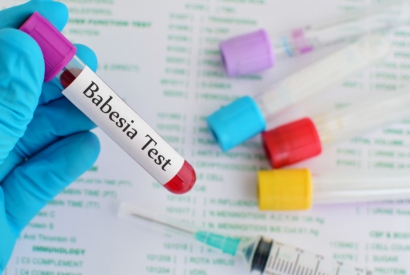
Lyme Disease Co-infections - Babesia
Babesia is a parasitic protozoan that resembles a lot of malaria, but is transmitted by ticks rather than mosquitoes, unlike it. Babesia infection often coexists with Lyme disease and / or other tick-borne infections. The disease caused by the protozoan Babesia is called babesiosis.
SYMPTOMS
The symptoms of babesiosis infection range from mild to severe. Mild forms very often go unrecognized because they are mistakenly taken for symptoms of Lyme disease. Early adopters often report high fever and chills. Chronic infections may be mildly symptomatic, and the most common symptoms are: intermittent fever or low-grade fever, chills and joint pain, chronic fatigue syndrome, sweating, and "inability to take a full breath".
Moreover, in the course of infection with Babesia, inflammation of the liver, kidneys and spleen may occur as a result of blockage of capillary blood vessels and microcirculation stagnation due to deposition of fragments of damaged erythrocytes in the vessels.
DIAGNOSTICS
.png)
Several laboratory tests are available for the diagnosis of bebesiosis.
Blood microscopic examination
The purpose of microscopic examination of blood is to check the presence of intra-erythrocyte forms of the pathogenic parasite Babesia (Babesia spp.) In the peripheral blood.
However, when carrying out this test, it should be remembered that in the early stage of the disease, the rate of red blood cell infection may be less than 1%, so it may be necessary to make several smears over a period of several days to confirm the diagnosis.
PCR test
If the result of a microscopic blood smear test is negative, but there is still a suspicion of bebesiosis, molecular tests (PCR) can be performed to detect the genetic material of the Babesia protozoan.
Immunofluorescence (IFA) of IgM and IgG antibodies
Immunofluorescence (IFA) of IgM and IgG antibodies is sometimes used to confirm the diagnosis of babesiosis. Be aware that anti-Babesia antibodies can remain high for months or even years after the disease has cleared. Therefore, this test is not a reliable indicator of an active infection.
Additional diagnostic parameters
Since Babesia lyses red blood cells, people infected with this protozoan often develop haemolytic anemia, as well as lymphopenia and thrombocytopenia. Increased levels of serum lactate dehydrogenase are also common, as are hyperbilirubinemia and increased erythrocyte sedimentation rate.
IMPORTANT INFORMATION ABOUT THE MECHANISM OF BABESIA ACTION WHICH NEEDS TO BE TAKEN INTO ACCOUNT WHEN PLANNING THERAPY:
Babesia penetrates into red blood cells - erythrocytes, where, by developing and reproducing, it destroys them. In addition, in the course of Babesia infection, there may be blockage of capillary blood vessels and microcirculation stagnation due to the deposition of fragments of damaged erythrocytes in the vessels. Their presence in the bloodstream can cause inflammation of the liver, kidneys and spleen.
In addition, Babesia uses two distinctive mechanisms to defend against the human immune system:
1. Babesia significantly inhibits the production of nitric oxide (NO) in the human body.
When the parasite attacks the red blood cells, the red blood cells release nitric oxide (NO) as one of the main defense mechanisms. Nitric oxide is a toxic gas to many bacteria and intracellular parasites, including Babesia. So Babesia has developed a defense mechanism: it secretes a component very similar to arginase, which is naturally present in the body. Arginase is an enzyme which feedback inhibits the production of NO by red blood cells; inactivates L-arginine, which is an essential substrate in the synthesis of NO. Babesia is very sensitive to L-arginine, therefore supplementation with L-arginine helps to inhibit Babesia infection.
2. Babesia has the ability to alter the immune polarity, thereby changing the human immune response from Th 1 to Th 2.
The immune T cells (abbreviated as Th) become active during infection. Depending on the type of infection, the body stimulates the production of various types of cells: Th 1, Th 2, Th3, Th 9 etc. It is important because a given pathogen is usually fought with a given immune response, and a bad fit of the mechanism to the pathogen causes that the body cannot eliminate the pathogen in question. Th1 cells participate in cell-type responses against intracellular pathogens. On the other hand, Th2 lymphocytes are the basic cells determining the mechanisms of the humoral response against extracellular pathogens. This mechanism is used by most Lyme co-infections that reside intracellularly. This allows them to effectively inhibit the proper immune reaction. The Th2 polarized pattern is associated with numerous autoimmune conditions such as lupus or systemic scleroderma.
The following steps should therefore be taken into account in the treatment of Babesia:
1. Antiprotozoal activity.
2. Protection of red blood cells, but also protection of the endothelium, spleen, liver and kidneys.
3. Modulation of the immune response, regulation of the cytokine cascade, inhibition of arginase production, increase in L-arginine and nitric oxide (NO) levels.
4. Antimicrobial action.
HERBS AND SUPPLEMENTS FOR BABESIA INFECTION ACCORDING TO. BUHNER PROTOCOL:

Stephen Harrod Buhner delved very precisely into the mechanism of action of the Babesia protozoan and selected a set of herbs effective in combating Babesia with great meticulousness.
His basic suggestion includes:
• Sida acuta
• Alchornea
• Cryptolepis
For more persistent infection he proposes extended protocol which includes:
• Sida acuta
• Cryptolepis
• Bidens pilosa
• Artemisinin
• Salvia miltiorrhiza
• Standardized Milk thistle
• Ashwagandha
• Korean ginseng
• Licorice
• Schisandra
• L-arginine
• Vitamin B2
The full protocol is detailed in Stephen Harrod Buhner's publication "Natural Treatments for Lyme Coinfections: Anaplasma, Babesia, and Ehrlichia."

 Boosting Your Libido Naturally with Herbal Supplements
Boosting Your Libido Naturally with Herbal Supplements
 Unlocking Energy Potential: Shilajit's Impact on ATP Production and Vitalit
Unlocking Energy Potential: Shilajit's Impact on ATP Production and Vitalit
 Collagen's Role in Lyme Disease Recovery: Understanding Its Vital Benefits
Collagen's Role in Lyme Disease Recovery: Understanding Its Vital Benefits
 Helicobacter Pylori- Natural Treatment
Helicobacter Pylori- Natural Treatment
 Sleep and Immunity
Sleep and Immunity